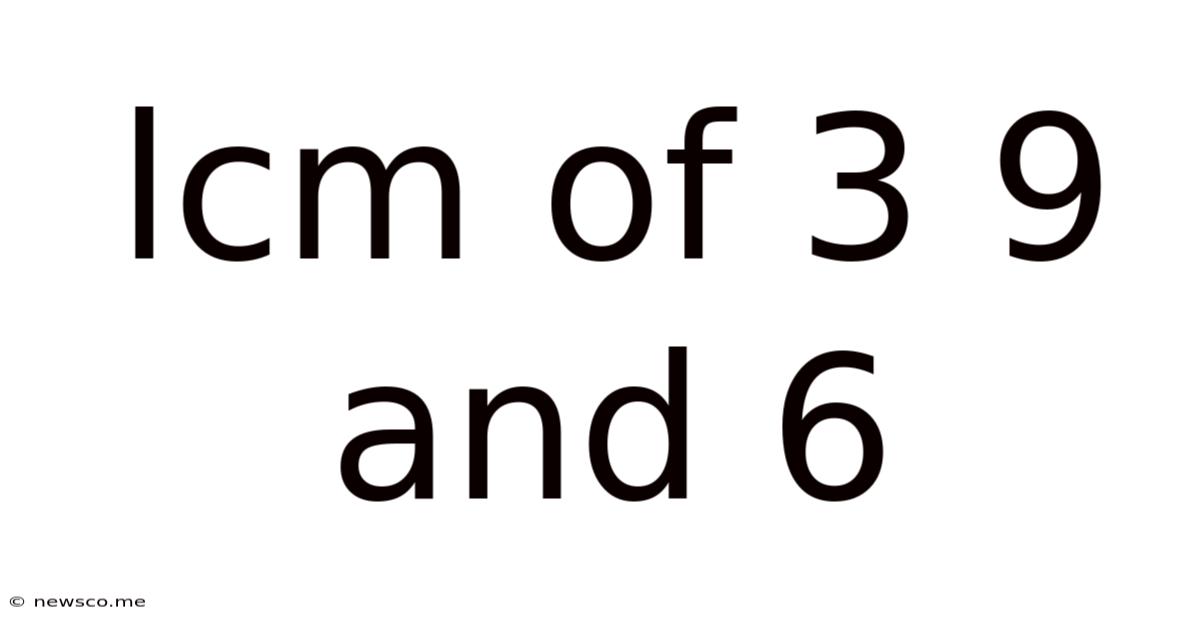Lcm Of 3 9 And 6
News Co
Apr 24, 2025 · 4 min read

Table of Contents
Finding the Least Common Multiple (LCM) of 3, 9, and 6: A Comprehensive Guide
Finding the least common multiple (LCM) is a fundamental concept in mathematics with applications across various fields, from scheduling tasks to simplifying fractions. This article delves deep into the process of calculating the LCM, specifically for the numbers 3, 9, and 6, employing multiple methods to illustrate the concept thoroughly. We'll also explore the underlying mathematical principles and practical applications of LCM calculations.
Understanding Least Common Multiple (LCM)
The least common multiple (LCM) of two or more integers is the smallest positive integer that is divisible by all the integers without leaving a remainder. It's a crucial concept in arithmetic and algebra, impacting areas like fraction simplification, solving equations, and understanding rhythmic patterns in music.
Let's break down the core idea: divisibility. A number is divisible by another if it can be divided evenly (with a remainder of zero). The LCM is the smallest number that satisfies this divisibility condition for all the given numbers.
Methods for Finding the LCM of 3, 9, and 6
There are several ways to calculate the LCM of 3, 9, and 6. We will explore three common methods: listing multiples, prime factorization, and using the greatest common divisor (GCD).
Method 1: Listing Multiples
This is a straightforward method, especially suitable for smaller numbers. We list the multiples of each number until we find the smallest multiple common to all three:
- Multiples of 3: 3, 6, 9, 12, 15, 18, 21, 24, 27, 30...
- Multiples of 9: 9, 18, 27, 36, 45, 54...
- Multiples of 6: 6, 12, 18, 24, 30, 36...
By comparing the lists, we observe that the smallest number appearing in all three lists is 18. Therefore, the LCM of 3, 9, and 6 is 18.
Method 2: Prime Factorization
This method is more efficient for larger numbers. We find the prime factorization of each number and then construct the LCM using the highest powers of all prime factors present.
- Prime factorization of 3: 3 = 3¹
- Prime factorization of 9: 9 = 3²
- Prime factorization of 6: 6 = 2¹ × 3¹
To find the LCM, we take the highest power of each prime factor present in the factorizations:
- The highest power of 2 is 2¹
- The highest power of 3 is 3²
Therefore, the LCM is 2¹ × 3² = 2 × 9 = 18.
Method 3: Using the Greatest Common Divisor (GCD)
The LCM and GCD (greatest common divisor) are closely related. There's a formula that connects them:
LCM(a, b, c) = (|a × b × c|) / GCD(a, b, c)
This formula is particularly useful when dealing with multiple numbers. However, for finding the GCD of multiple numbers, it is best to find the GCD of two numbers at a time and then find the GCD of the result and the remaining number.
First, let's find the GCD of 3 and 9 using the Euclidean algorithm:
9 = 3 × 3 + 0
The GCD(3, 9) = 3.
Next, let's find the GCD of 3 and 6:
6 = 3 × 2 + 0
The GCD(3, 6) = 3.
Thus the GCD(3, 9, 6) = 3.
Now, we can apply the formula:
LCM(3, 9, 6) = (3 × 9 × 6) / GCD(3, 9, 6) = 162 / 3 = 18
Applications of LCM
The LCM has wide-ranging applications in various fields:
Scheduling and Time Management
Imagine you have three tasks that repeat at different intervals: Task A repeats every 3 days, Task B every 9 days, and Task C every 6 days. The LCM(3, 9, 6) = 18 tells us that all three tasks will coincide again after 18 days. This principle is crucial in scheduling events, managing resources, and coordinating activities with recurring cycles.
Fraction Addition and Subtraction
To add or subtract fractions with different denominators, you need to find a common denominator. The LCM of the denominators is the least common denominator (LCD), simplifying calculations and ensuring accurate results.
Music Theory
Musical rhythms and time signatures often involve fractions. Finding the LCM helps determine when different rhythmic patterns will align or coincide, crucial for composing and understanding musical structures.
Engineering and Construction
In construction projects and engineering designs, the LCM is used for synchronizing work processes, managing material deliveries, and optimizing resource allocation.
Computer Science
In computer programming and algorithms, calculating LCM is fundamental for tasks involving synchronization, scheduling, and resource management.
Advanced Concepts and Extensions
The methods discussed above can be extended to calculate the LCM of more than three numbers. The prime factorization method remains particularly efficient for larger sets of numbers. Similarly, the GCD-based approach can be iteratively applied.
Conclusion
Calculating the least common multiple (LCM) is a vital skill with far-reaching practical applications. We have explored three efficient methods – listing multiples, prime factorization, and utilizing the GCD – to determine the LCM of 3, 9, and 6, which is 18. Understanding these methods empowers you to solve various mathematical problems and tackle real-world challenges involving recurring cycles, fractional calculations, and scheduling. The concepts and techniques discussed here provide a strong foundation for further exploration into number theory and its applications across diverse fields. Remember that consistent practice and understanding the underlying principles will improve your proficiency in LCM calculations.
Latest Posts
Related Post
Thank you for visiting our website which covers about Lcm Of 3 9 And 6 . We hope the information provided has been useful to you. Feel free to contact us if you have any questions or need further assistance. See you next time and don't miss to bookmark.